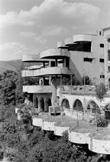KELLY WRITERS HOUSE
Erika Tapp
MOSTAR/SARAJEVO:
MODERNIST RUINS
ARTIST STATEMENT
My research has sought to explore the genre of buildings that were
constructed in the later half of the 20th Century. And this exhibit seeks
to examine the paradoxical situation caused by the war, of the modernist
building in ruin. This exhibit hopes to be as much about the war as it is
about how life has continued after the war. Rather than be appalled by the
terror of the war, I invite you to see that there is life thriving among
these ruins.
Modernist architecture in the former Yugoslavia rarely receives more than
a footnote in any text, whether about modern or Yugoslav architecture. The
Ottoman and Austro-Hungarian period buildings and planning projects
receive far more attention. The modernist architecture of Tito's
Yugoslavia and the period immediately following his death are able to
present to us a very interesting picture. On the one hand, state sponsored
projects do their best to remain nonspecific, that is, they resemble
buildings throughout Yugoslavia and in many ways throughout communist
Eastern Europe. This is the type of modernist architecture found in the
newer areas of Sarajevo. On the other hand, architects building in
provincial cities like Mostar often tried to express a regional aesthetic
in their buildings. This aspiration was never supported by the state,
though neither condemned. Patterns of patronage in Mostar and Sarajevo
reveal a tension between ethnic, or preferably regional, expression and
nationalistic goals long before the events of 1991-1995.
During the war many structures which were not valuable strategically were
destroyed simply because they were of cultural importance. Buildings like
the National Library in Sarajevo, the Stari Most (Old Bridge) in Mostar,
and the structures in the old town of Dubrovnik were among them. These
edifices represented a kind of collective past and simultaneously the
distinct cultural heritages of the various regions. Besides the genocidal
massacres which took their toll in human lives, there was another kind of
massacre occurring which has often been described as "urbicide".
Reconstruction efforts throughout the former Yugoslavia have focused on
the more "historic structures" of the Ottoman and Austro-Hungarian
periods. The infamy of the siege of Sarajevo has contributed to
significant international involvement in the reconstruction process. Much
of the physical reconstruction nears completion in this capital city,
though economic and emotional recovery is naturally enough a longer
process.
The destruction in the provincial capital of western Hercegovina, Mostar,
was far more serious than even in Sarajevo. The city was subjected to two
different two-month sieges that nearly destroyed the Ottoman, east side of
the city. The reconstruction effort in Mostar is headed by the Bosnian
architect, Amir Pasic, once a celebrated planner and architect who now
devotes himself full time to the reconstruction process in Mostar. He has
found financial backing both in the Aga Khan Trust for Culture, an
organization which finances a wide range of projects affiliated with
architecture in Islamic countries, and the World Monuments Fund, an
international organization which provides support for saving monuments
throughout the world. This project, like other reconstruction projects,
focuses attention and monies on older constructions, leaving more recent
buildings to be dealt with by commercial interests. The reconstruction
process in Mostar has moved at a far slower pace then in the national
capital. We often assume that the story ends once peace has been
established. And for the architects of the Aga Khan office in Mostar, that
was when their work began and continues to this day.
This project has been made possible by a very wonderful group of people. I
must thank Amir Pasic, who has supported me on numerous occasions while in
Bosnia and Istanbul; Laura Briggs, Medina Lasansky, Renata Holod, and
Robert Wojtowicz who served as faculty advisors at Cornell University and
the University of Pennsylvania; the Department of Art History at Penn for
financial assistance in the last moments of this exhibit; many thanks to
John Henry Rice, whose photographic and editorial expertise was invaluable
in the execution of the exhibit; my mother and father for support both
financial and emotional; and especially to Peter Schwarz and the Kelly
Writers House for hosting this work.
My experience of postwar Bosnia Herzegovina began in the summer of 2000 at
the Mostar 2004 workshop, an annual gathering designed to educate
architects, planners, and students about the issues of postwar
reconstruction in Mostar. It was a truly illuminating experience. Mostar,
and the whole of Bosnia, is the kind of place that infects all who visit,
making just one trip almost an impossibility. I too fell under its
spell.
